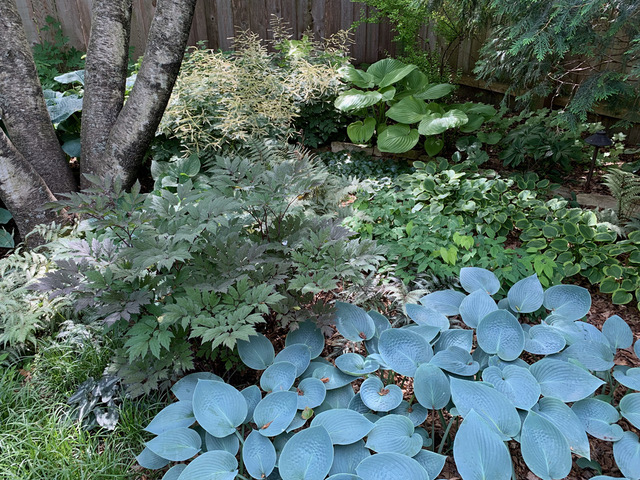
My name is John Cannon, and I garden in Madison, Wisconsin, Zones 4b–5a. I have been gardening on this residential lot for more than 30 years, and I am working to create a four-season garden. Like many of you, I travel and visit gardens often to observe and learn all that I can. I can translate and use ideas that will work in my own garden. Although there are now established bones in the garden, it is always a work in progress. I really enjoy fine-tuning by creating plant vignettes and interesting combinations using harmonizing or contrasting foliage colors, shapes, and textures. If the plant has flowers, it is considered a bonus! I’m looking forward to making more changes to other parts of the garden as this spring unfolds. I have enjoyed seeing other gardener’s gardens on GPOD for years, but I haven’t posted until now. These pictures were all taken in the garden in the last few years in June. In these times, as ever, the garden is a refuge that I am so very thankful for and enjoy daily.
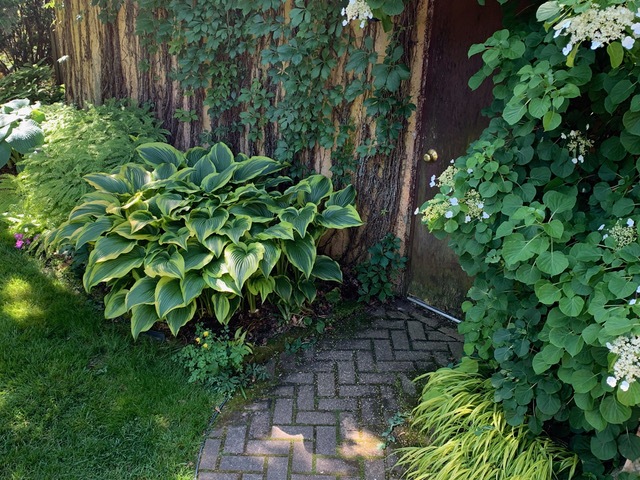
A north-facing garage bed with Hydrangea petiolaris (climbing hydrangea, Zones 4–8) and Virginia creeper (Parthenocissus quinquefolia, Zones 3–9) scrambling up the garage walls, Hakonechloa macra ‘Aureola’ (golden Japanese forest grass, Zones 5–9), a massive Hosta montana ‘Aureomarginata’ (Zones 3–9), lacy Adiantum pedatum (northern maiden hair fern, Zones 3–8), and Hosta sieboldiana ‘Elegans’ (Zones 3–9).
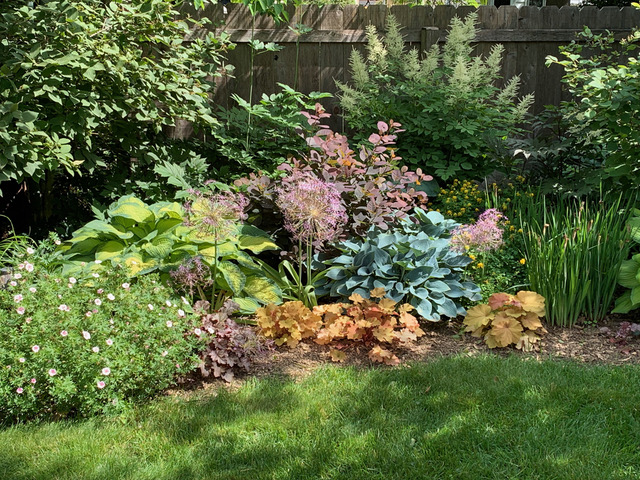
Border left to right: A spring favorite for fragrant blooms is Viburnum × juddii (Judd viburnum, Zones 4–8) with the pink-flowered Geranium striatum (bloody geranium, Zones 4–8) in front, Actaea racemosa (black cohosh, Zones 3–8), Hosta ‘Paul’s Glory’, Heuchera ‘Frosted Violet’ and ‘Caramel’, Hosta ‘Halcyon’, Cotinus ‘Nordine’ (smoke bush, Zonse 5–8), creamy plumes of Aruncus dioicus (goat’s beard, Zones 4–8), Actaea ‘Brunette’ (bugbane, Zones 3–8), Corydalis lutea (yellow corydalis, Zones 4–8), Iris ‘Ego’ (‘Ego’ Siberian iris, Zones 3–8) and Fothergilla gardenii (dwarf fothergilla, Zones 4–8) for wonderful autumn color. Giant Allium christophii (star of Persia, Zones 4–8) with flower heads reminiscent of fireworks add to the fun.
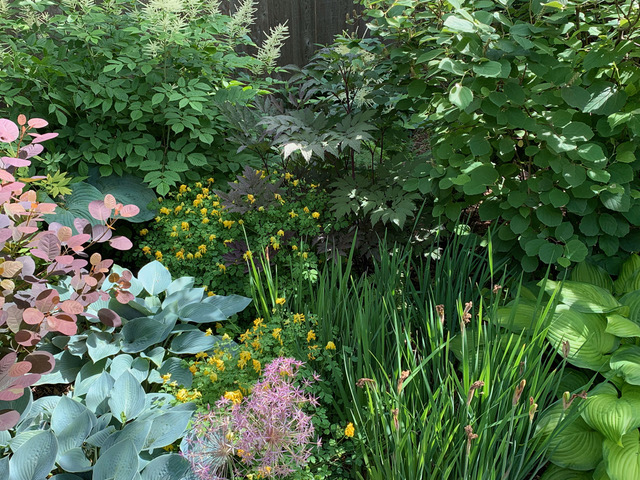
Detail of above border with the Cotinus that I coppice every year in spring, along with Hosta ‘Halcyon’, Corydalis lutea, Allium christophii flowers, Siberian iris seed heads, and Hosta ‘Guacamole’ along the front. Aruncus dioicus, Cimicifuga ‘Brunette’, and Fothergilla gardenii are in the background.
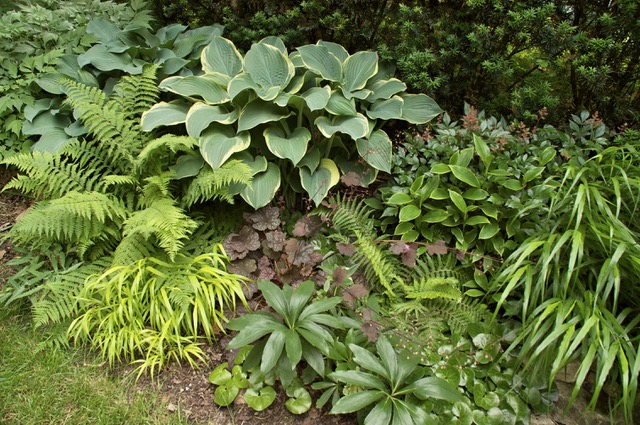
In another corner, left to right: Actaea racemosa, Hosta ‘Krossa Regal’ and ‘Regal Splendor’ with Athyrium, Hakonechloa ‘All Gold’, a bronze Heuchera, Tricyrtis ‘Gilt Edge’ (toad lily, Zones 4–9), and a pink astilbe in front of a hedge of Taxus hicksii (yew, Zones 4–7).
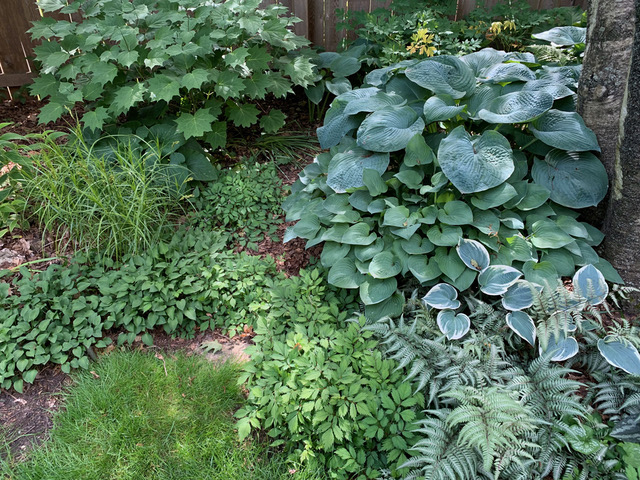
Border left to right: Tricyrtis, Carex muskingumensis ‘Oheme’ (Oheme sedge, Zones 4–7), Kirengeshoma palmata (yellow wax-bells, Zones 5–8), Dicentra spectabilis (bleeding heart, Zones 2–8) in back of Hosta ‘Big Daddy’ with a dwarf hosta, Astilbe chinensis pumila (dwarf astilbe, Zones 4–8), Hosta ‘Pearl Lake’ and ‘El Niño’, and Athyrium nipponicum (Japanese fern, Zones 3–8) along the front edge.

Continuing along the back border with Actaea atropurpurea, Carex ’Silver Sceptre’ (‘Silver Sceptre’ sedge, Zones 5–9), Hosta ‘Halcyon’, Aruncus ‘Misty Lace’, Hosta ’Sum and Substance’, with smaller hostas, ferns, and epimediums. I love the color echoes, harmonies, and textural contrasts provided by the perennials’ fresh foliage.
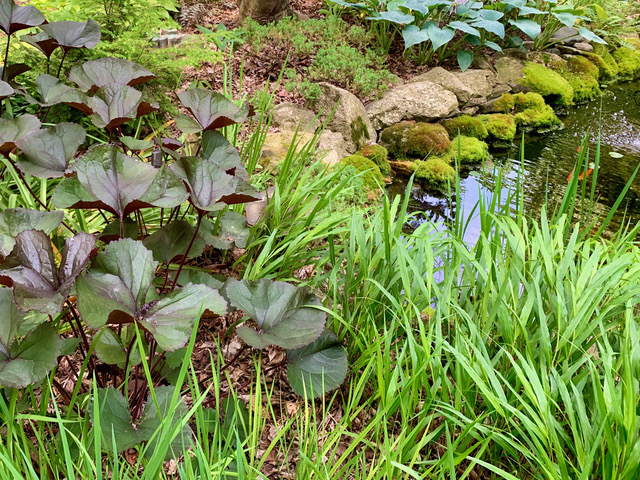
This is one corner of my pond surrounded by Hakonechola macra, bronze-leaved Ligularia ‘Britt Marie Crawford’ (leopard plant, Zones 4–8) with Tsuga canadensis ‘Golden Dutchess’ (eastern hemlock, Zones 3–7) behind, Juniperus chinensis (Chinese juniper, Zones 3–9), and Hosta ‘Blue Umbrellas’ along the edge of the pond.
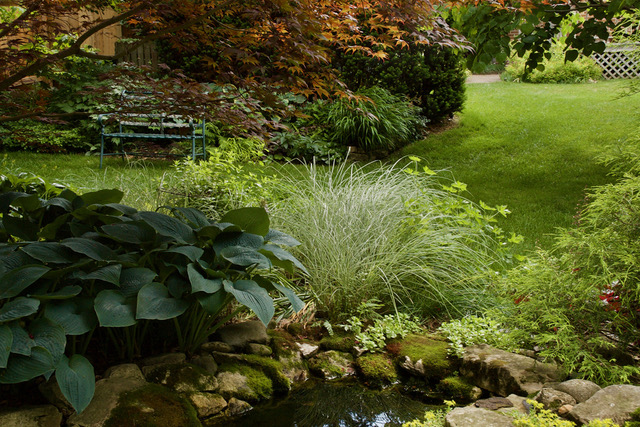
Another glimpse of the pond and garden with Hosta ‘Blue Umbrellas’, Miscanthus sinensis ‘Morning Light’ (Japanese silver grass, Zones 4–9), and Chamaecyparis ‘Gold Mop’ (‘Gold Mop’ false cypress, Zones 5–7). A 25-year-old Acer palmatum (Japanese maple, Zones 4–9) provides a focal point and dappled shade for the pond and plantings in this bed.
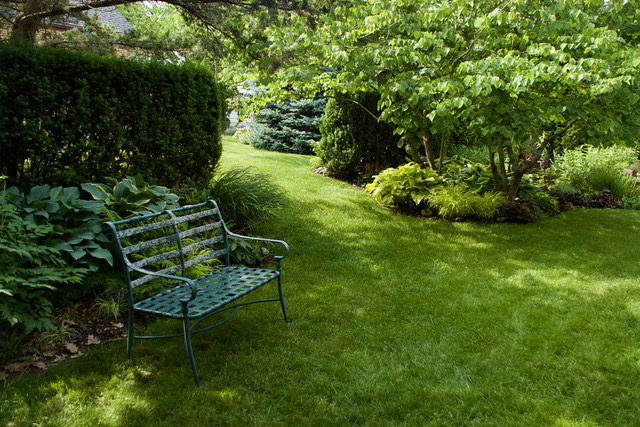
This bench provides a great spot to relax and take in the surrounding garden.
Have a garden you’d like to share?
Have photos to share? We’d love to see your garden, a particular collection of plants you love, or a wonderful garden you had the chance to visit!
To submit, send 5-10 photos to [email protected] along with some information about the plants in the pictures and where you took the photos. We’d love to hear where you are located, how long you’ve been gardening, successes you are proud of, failures you learned from, hopes for the future, favorite plants, or funny stories from your garden.
If you want to send photos in separate emails to the GPOD email box that is just fine.
Have a mobile phone? Tag your photos on Facebook, Instagram or Twitter with #FineGardening!
You don’t have to be a professional garden photographer – check out our garden photography tips!
Do you receive the GPOD by email yet? Sign up here.



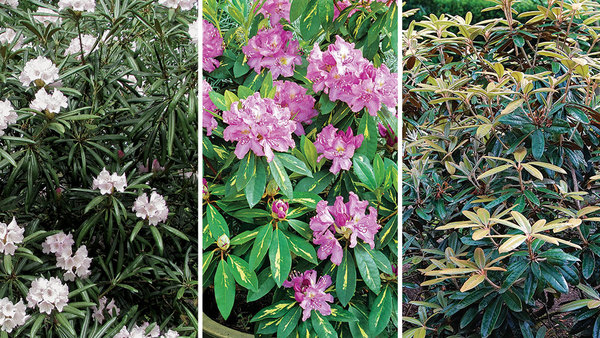













Comments
I too learned to love colored foliage when I lived with a shady yard. The development of Coleus and Heuchera was a bane for gardeners. My favorite hosta is Halcyon, you used it well, a wonderful oasis! Carrie
Thanks for posting!
Wonderful to know so many of the plants we're also using will work out so well with companion plants we went with. In a few places, your garden vignettes could have been pull from our place! The similarities were many!
indeed, you have mastered the art of making fully distinct foliage adjacencies in both texture and color! It's so evident in your well identified photos. The care in documenting all your plant cultivar names including the various hosta is quite helpful to those looking to recreate some of your pairings.
All that said, I do sometimes find that vignettes that include too many distinctly different foliage colors to be jarring: golden, blue, red, pale green, deep green, bronze. Often, the photos help reveal which color stands out as the one which might be removed to improve the rest.
I agree and do try to limit my foliage color choices, sometimes by transitioning from warm to cool tones or by using greens as a buffer between different hues. Often the colored foliage grabs my eye and then I can discover what else that plant is paired with and how it is used with other plants. Thank you.
Beautifully done. I live in a similar environment in Michigan and appreciate how you have combined the different colors and textures. Well done!
Very peaceful and love all the contrasts. Good imagination.
I love your garden! We have a similar style garden in our zone 5b to 6a in North Oxford MA. We share many of your plant choices. Thanks for sharing.
Beautiful, lush garden! You're so lucky to garden in such a mild climate, instead of an extreme 9B where I live! You've taken good advantage!
How do you get grass to grow in the bench area? It looks so shady.
Thank you. The picture was taken at one point during the day when it was/is shady. And truth be told, that bench doesn't get used too much by this gardener.
Beautiful garden, John. Great combinations. Now I'm trying to remember if I've visited your garden with the Wisconsin Hardy Plant Society. There are so many wonderful gardens in the Madison area I can't keep track of them all.
I love your foliage garden, so relaxing and full of interest. Your pond is so beautiful with the moss growing on the stones around it, and the garden bench is a nice resting place to take in all the calmness in your garden. Thanks for sharing your photos!
JOHN, I have so many things to share with you and i ask you to plse know that my only goal is to supplement the fantastic garden you have already created. In my 33 year Cotton-Arbo retum i have many scenarios similar to yours.
- In my woodland garden, i have been thrilled with Saruma Henryii- great foliage shapes with long-blooming lovely pale yellow flowers. Ditto Brunneras. Symphytum Axminster Gold. Moister shade- Rogersia- killer foliage! V.Dry shade- Geranium Macro. Album [v.hard to source. Avant Gardens]
- A bench can benefit greatly with anchoring elements like urns or direct plantings in the grass like 2-3 foot variegated grass or short shrubs...
The fantastic lesson i just learned from the French woman's GPOD last week- was to prune a cotinus like a standard/small tree with few trunks. did you see her fantastic
idea? so useful!
What a great thing you have accomplished, john.
i'd love to talk further
[email protected]
Thank you Mindy,
Yes, I saw the posting by the gardener using the Cotinus as a small tree, and with great results.
I have also used many of the plants you mentioned in other corners of my garden, and I'll have to keep an eye out for the others.
That bench does not stay stationary, it moves around from time to time.
get more benches!!! we're all getting older [says the 69 year old moving-handicapped gardener] !!!
mindy
p.s. would love to see more photos of your handsome mossy pond!
i forgot to mention shade/sun long-lasting tall plumes- Polygonum Polymorpha.
Really lovely and well done. Congratulations.
A perfectly lovely garden - so peaceful - just what we need in these times. The color of the Halcyon hostas is wonderful.
Love all those hostas. Sure wish mine would get as large as yours.
Looks very peaceful and calming
Log in or create an account to post a comment.
Sign up Log in